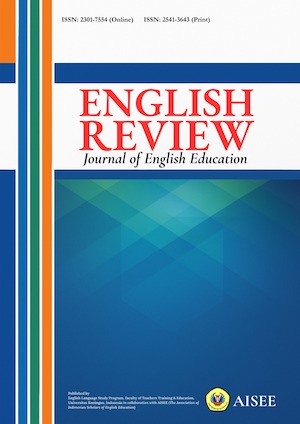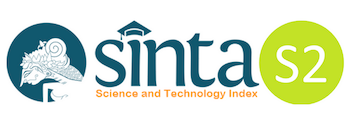BEYOND FALLACIES: STRENGTHS AND QUALIFICATIONS FOR ENGLISH TEACHING PROFESSION IN INDONESIA
Abstract
Proposing the idea of perception toward native English-speaking teachers (NESTs) and non-native English-speaking teachers (non-NESTs), this research was motivated by the historical changes from the ‘fallacies’ in finding the most suitable English teachers between the two categories to discussing their potential if those teachers collaborated in team teaching. This study aimed to reveal a) the top three language skills pre-service English teachers perceived to improve if taught by either NESTs or Indonesian English teachers and b) the priority list of qualifications to meet by them. The quantitative findings from a close-ended questionnaire involving 186 pre-service English teachers in the Department of English Education at an Indonesian university indicated that the respondents tend to view NESTs as good models to teach oral-aural skills such as listening, pronunciation, and speaking. On the other hand, Indonesian English teachers could better-supporting students in teaching written skills such as grammar, vocabulary, and writing skills, which are more related to accuracy and language features. For the second objective, our results indicated that our respondents agreed that the English teaching profession should have fair treatment. Both NESTs and Indonesian English teachers are required to have relevant academic qualifications, and teaching experiences were viewed.References
Adara, R. A. (2019). The differences in students’ attitudes and perceptions of NEST and NNEST. Leksika: Jurnal Bahasa, Sastra Dan Pengajarannya, 13(2), 72–81. https://doi.org/http://dx.doi.org/10.30595/lks.v13i2.4654
Ahn, S. (2020). Non-native English-speaking teachers in Korean English classrooms: Reflections through critical performative pedagogy. Reflective Practice, 21(1), 68–80. https://doi.org/10.1080/14623943.2019.1708713
Al-Furqan, A., & Rahman, A. A. (2019). The analysis of Native and Non-native EFL teachers in Indonesia: A review of literature. Asian EFL Journal, 23(3.4), 316–333.
Árva, V., & Medgyes, P. (2000). Native and non-native teachers in the classroom. System, 28(3), 355–372. https://doi.org/10.1016/S0346-251X(00)00017-8
Bayyurt, Y. (2018). Equity and Inclusivity for NESTs and NNESTs. In The TESOL Encyclopedia of English Language Teaching (pp. 1–6). Hoboken, NJ, USA: John Wiley & Sons, Inc. https://doi.org/10.1002/9781118784235.eelt0017
Benke, E., & Medgyes, P. (2005). Differences in Teaching Behaviour between Native and Non-Native Speaker Teachers: As seen by the Learners. In E. Llurda (Ed.), Non-Native Language Teachers: Perceptions, Challenges and Contributions to the Profession (pp. 195–215). New York: Springer. https://doi.org/10.1007/0-387-24565-0_11
Braine, G. (2010). Nonnative speaker english teachers. New York: Routledge. https://doi.org/10.4324/9780203856710
Braine, G. (2018). Non‐native‐speaker English teachers. In The Encyclopedia of Applied Linguistics (pp. 1–5). Wiley. https://doi.org/10.1002/9781405198431.wbeal0871.pub2
Bryant, D. A. (2016). Revisiting native speaking teachers of English in Hong Kong. International Journal of Comparative Education and Development, 18(1), 53–68. https://doi.org/10.1108/IJCED-10-2015-0002
Carless, D. (2006). Effective team teaching between local and native-speaking English teachers. Language and Education, 20(6), 463–477. https://doi.org/10.2167/le627.0
Chun, S. Y. (2014). EFL learners’ beliefs about native and non-native English-speaking teachers: Perceived strengths, weaknesses, and preferences. Journal of Multilingual and Multicultural Development, 35(6), 563–579. https://doi.org/10.1080/01434632.2014.889141
Cook, V. (2005). Basing teaching on the L2 User (E. Liurda, ed.). New York: Springer. https://doi.org/10.1007/0-387-24565-0_4
Fraenkel, J. R., Wallen, N. E., & Hyun, H. H. (2021). How to design and evaluate research in education (11th ed.). McGraw Hill.
Harsanti, H. R., & Manara, C. (2021). “I Have to Teach The ‘English’ English”: Native-speakerism ideology among the English teachers. Indonesian Journal of Applied Linguistics, 11(2), 330–340. https://doi.org/10.17509/ijal.v11i2.26379
Heo, J. (2016). Power, balance and identity: An insight into intercultural team teaching. In F. Copland, S. Garton, & S. Mann (Eds.), LETs and NESTs: Voices, Views and Vignettes (pp. 164–178). London: British Council.
Holliday, A. (2005). The struggle to teach English as an international language. Oxford: Oxford University Press.
Houghton, S. A., & Rivers, D. J. (2013). Native-Speakerism in Japan: Intergroup Dynamics in Foreign Language Education. Bristol: Multilingual Matters.
Hu, Y. (2007). China’s foreign language policy on primary English education: What’s behind it? Language Policy, 6(3–4), 359–376. https://doi.org/10.1007/s10993-007-9052-9
Jang, H., & Wood, J. (2019). Native vs Non-Native English Speaking Teachers: An analysis of business schools in the tertiary education sector. The Journal of AsiaTEFL, 16(3), 944–957. https://doi.org/10.18823/asiatefl.2019.16.3.11.944
Jeon, M., & Lee, J. (2006). Hiring native-speaking English teachers in East Asian countries. English Today, 22(4), 53–58. https://doi.org/10.1017/S0266078406004093
Kaplan, R. B., Baldauf, R. B., & Kamwangamalu, N. (2011). Why educational language plans sometimes fail. Current Issues in Language Planning, 12(2), 105–124. https://doi.org/10.1080/14664208.2011.591716
Khánh, T. T. M., & Spencer-Oatey, H. (2016). Managing relations in crossnational team teaching pairs: Insights from rapport-sensitive incidents. In F. Copland, S. Garton, & S. Mann (Eds.), LETs and NESTs: Voices, views and vignettes (pp. 179–194). London: British Council.
Kirana, S. N., & Methitham, P. (2022). Native-speakerism in a locally developed Indonesian EFL textbook: A critical discourse study. Journal of English and Education, 8(1), 1–15.
Kirkpatrick, A. (2012). English in ASEAN: Implications for regional multilingualism. Journal of Multilingual and Multicultural Development, 33(4), 331–344. https://doi.org/10.1080/01434632.2012.661433
Kramadibrata, A. (2016). The Halo surrounding native English speaker teachers in Indonesia. Indonesian Journal of Applied Linguistics, 5(2), 282. https://doi.org/10.17509/ijal.v5i2.1352
Lawrence, L. (2016). Responsibility without power: Native-speaker experiences of team teaching in Japanese secondary schools. In F. Copland, S. Garton, & S. Mann (Eds.), LETs and NESTs: Voices, Views and Vignettes (pp. 20–36). London: British Council.
Ma, L. P. F. (2012). Advantages and disadvantages of Native- and Nonnative-English-speaking teachers: Student perceptions in Hong Kong. TESOL Quarterly, 46(2), 280–305. https://doi.org/10.1002/tesq.21
Mahboob, A., & Golden, R. (2013). Looking for native speakers of english: Discrimination in English language teaching job advertisements. Voices in Asia, 1, 72–81.
Medgyes, P. (1994). The non-native teacher. New York: Palgrave MacMillan.
Mhd Fauzi, N., & Hashim, H. (2020). Apple vs. Mangosteen: A qualitative study of students’ perception towards Native and Non-Native English-Speaking teachers. Journal of Education and E-Learning Research, 7(2), 218–228. https://doi.org/10.20448/journal.509.2020.72.218.228
Phillipson, R. (1992). Linguistic imperialism. Oxford: Oxford University Press.
Rao, Z., & Chen, H. (2020). Teachers’ perceptions of difficulties in team teaching between local- and native-English-speaking teachers in EFL teaching. Journal of Multilingual and Multicultural Development, 41(4), 333–347. https://doi.org/10.1080/01434632.2019.1620753
Rao, Z., & Yuan, H. (2016). Employing native-English-speaking teachers in China: Benefits, problems and solutions. English Today, 32(4), 12–18. https://doi.org/10.1017/S0266078415000590
Sarie, R. F. (2018). Examining the issue of native-speakerism in English language teaching in Indonesian context. LINGUA: JURNAL BAHASA & SASTRA, 18(2), 87–95.
Selvi, A. F. (2010). All teachers are equal, but some teachers are more equal than others: Trend analysis of job advertisements in English language teaching. WATESOL NNEST Caucus Annual Review, 1, 156–181.
Silalahi, R. M. P. (2021). Nativespeakerism and World Englishes: Teachers perception towards non-native English varieties. Journal of English Language and Culture, 11(2), 73–84. https://doi.org/10.30813/jelc.v11i2.2609
Silalahi, R. M. P., & Widianingtyas, N. (2022). ‘Hello, I’m a native speaker’: Nonnative tutors’ perspectives on native-speakerism ideology. Language Literacy: Journal of Linguistics, Literature, and Language Teaching, 6(1), 142–153. https://doi.org/10.30743/ll.v6i1.5237
Sung, C. C. M. (2014). An exploratory study of Hong Kong students’ perceptions of native and non-native English-speaking teachers in ELT. Asian Englishes, 16(1), 32–46. https://doi.org/10.1080/13488678.2014.880252
Sutherland, S. (2014). Team teaching: Four Barriers to native English speaking assistant teachers’ ability to model native English in Japanese classrooms. Asian EFL Journal, 16(2), 156–180.
Walkinshaw, I., & Oanh, D. H. (2014). Native and non-native English language teachers: Student perceptions in Vietnam and Japan. SAGE Open, 4(2), 215824401453445. https://doi.org/10.1177/2158244014534451
Widdowson, H. G. (1992). ELT and EL Teachers: Matters arising. ELT Journal, 46(4), 333–339. https://doi.org/10.1093/elt/46.4.333
Wu, A. M. C. (2021). Native-English-Speaking Teachers: Do they bring values to EFL Learners? A study on listening proficiency of Taiwanese elementary school students. English Teaching & Learning, 45(1), 89–107. https://doi.org/10.1007/s42321-020-00064-0
Yazan, B. (2018). Identity and NNESTs. In The TESOL Encyclopedia of English Language Teaching (pp. 1–7). Hoboken, NJ, USA: John Wiley & Sons, Inc. https://doi.org/10.1002/9781118784235.eelt0020
Yim, S. Y. (2018). Teaching English in a foreign country: Legitimate peripheral participation of a native English-speaking teacher. System, 78, 213–223. https://doi.org/10.1016/j.system.2018.09.008
Zein, M. S. (2017). To postpone or not to postpone? Examining access policy on early foreign language learning from second language acquisition and language planning and policy perspectives. Applied Linguistics Review, 8(4), 419–439. https://doi.org/10.1515/applirev-2016-1044
All articles published in English Review: Journal of English Education (ERJEE) are licensed under the Creative Commons Attribution 4.0 International License (CC BY 4.0).
Copyright Ownership
Authors retain the copyright of their articles and grant ERJEE the right of first publication. The journal is granted a non-exclusive license to publish, reproduce, and distribute the article in any format, medium, or platform, provided that proper credit is given to the original authors.
License Terms – CC BY 4.0
Under the Creative Commons Attribution 4.0 International License, others are free to:
- Share — copy and redistribute the material in any medium or format
- Adapt — remix, transform, and build upon the material for any purpose, even commercially
As long as they:
- Provide appropriate credit to the original author(s) and source
- Provide a link to the license (https://creativecommons.org/licenses/by/4.0/)
- Indicate if any changes were made
There are no restrictions on the reuse, reproduction, or adaptation of published articles as long as attribution is properly given.
Author Warranties
By submitting a manuscript to ERJEE, authors confirm that:
- The work is original and does not infringe any existing copyright.
- The manuscript has not been previously published and is not under consideration elsewhere.
- All sources and references are appropriately acknowledged.
- Necessary permissions have been obtained for any copyrighted materials used.









